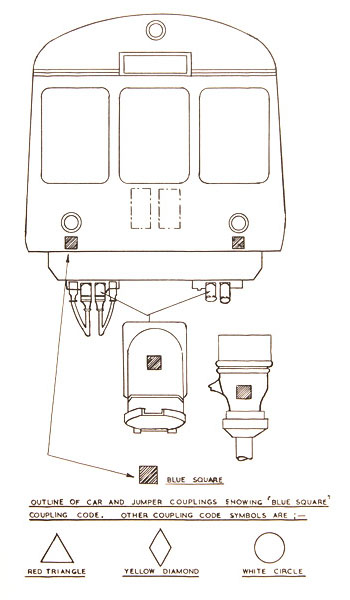Coupling Codes

Coupling codes were introduced circa 1956 as a way of identifying which different DMU types could be coupled together to work in multiple as there were variations in the electrical control systems.
 |
Red Triangle West Riding Derby Lightweights Class 127 |
 |
Yellow Diamond Other Derby Lightweights 79xxx series Met Camms Class 129 |
 |
White Circle 79xxx series Swindons Class 126 |
 |
Orange Star Class 125 |
 |
Blue Square All other vehicles |
The first vehicles delivered, the West Riding Derby Lightweights would be given the Red Triangle coupling code, which enabled them to work in multiples of up to eight power cars. Jumpers were at waist level. For the next sets delivered, the remaining Derby Lightweights and the Met-Camm Lightweights, a change had been made from hydraulic to mechanical transmission with a Yellow Diamond code. Jumpers were again at waist level. When not in use on the outer ends, the cables could be removed for storage inside the vehicles.
The electrical system evolved for the introduction of the first Swindon DMUs, the 79xxx Inter City vehicles, the White Circle system. These vehicles were distinct in having no through air pipe between vehicles, so each power car depended on producing it’s own air. They were also unique in having no jumpers or sockets on the outer ends of the ‘leading’ type power cars, and jumpers from the 'intermediate' power cars were kept in the guards van. The jumper sockets were moved to the buffer beam, an operating change as it was found that most coupling/uncoupling was done at track rather than platform level.
The next vehicles, Classes 105 and 114 which arrived at the same time, were the first cars to have what became the standard coupling code, Blue Square. However there were some teething problems with this and there was temporarily a diagonal stripe added to the blue square on the 114s, a code that was also used on a Class 116 set. Class 114s were also unusual for Blue Square sets in that the jumper sockets are mounted rotated 180 degree from other classes.
All future vehicles, with the exception of three classes, were built to Blue Square.
The Class 125s were the only vehicles to receive the Orange Star coupling code, meaning they couldn’t work with any other sets, an important factor in their early withdrawal. These hydraulic vehicles had an air throttle control system (meaning an extra air connection on the bufferbeam), and only one jumper on the right of the bufferbeam. Their prototype — 50000/56000 — is believed to have started with this sytem then be converted to a Blue Square.
The second batch of Swindon Inter-City vehicles (the Class 126s) were also given the White Circle system, although this was actually incompatible with the original White Circles. The 1956 vehicles had a different type of throttle control/motor and modifications had to be done to the early type to allow the sets to work together. On the second batch jumpers were fitted to the front of the ‘leading’ type vehicles. All the control equipment and the electrical circuits on the 126s were identical to the Blue Square system, with the exception of the way the jumper sockets were wired.
Although all passenger carrying Cravens vehicles were Blue Square, the three Class 129 DMUs were fitted with the Yellow Diamond system as they were built to work with the Yellow Diamond Derby Lightweights.
Whilst built with a Blue Square control system the Class 127s were reclassified in 1969 as Red Triangle. As a Blue Square type they could be coupled to mechanical unit, when driving from the hydraulic set the driver had to consider the needs of the mechanical set as if the gears are not changed properly then overheating and a fire would occur. After a serious incident of this nature they were reclassified to prevent it happening again. All the Red Triangle Derby Lightweights had been withdrawn by this time — the Class 127s were in no way compatible with them, the change was in name only, no alterations to the control system was done.
More details:
Electrical Control Systems
Blue Square System
Yellow Diamond System
Back to:
Technology menu


